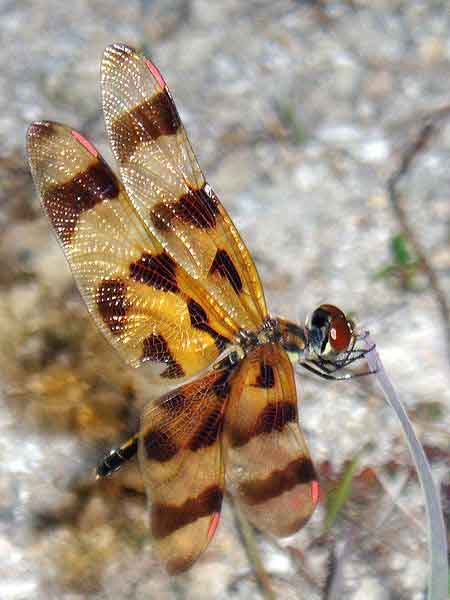
Celithemis eponina (*)
Superregnum: Eukaryota
Cladus: Unikonta
Cladus: Opisthokonta
Cladus: Holozoa
Regnum: Animalia
Subregnum: Eumetazoa
Cladus: Bilateria
Cladus: Nephrozoa
Cladus: Protostomia
Cladus: Ecdysozoa
Cladus: Panarthropoda
Phylum: Arthropoda
Subphylum: Hexapoda
Classis: Insecta
Cladus: Dicondylia
Subclassis: Pterygota
Cladus: Metapterygota
Cladus: Odonatoptera
Cladus: Holodonata
Ordo: Odonata
Subordo: Epiprocta
Infraordo: Anisoptera
Superfamilia: Libelluloidea
Familia:Libellulidae
Subfamilia: Leucorrhiniinae
Genus: Celithemis
Species: C. eponina
The Halloween pennant (Celithemis eponina) is a species of dragonfly in the family Libellulidae. It is native to eastern North America, including Ontario in Canada and the United States as far west as Colorado.[1]
Description
The Halloween pennant has been described as looking very similar to a butterfly. Its wings are entirely orange-yellow in color with dark brown bands, the Halloween inspiration for its common name.[2] Dragonflies of its genus perch at the tips of plants, waving in the breeze like pennants.[3] The young has yellow markings, including a stripe on its back. The adult male and female may develop pale red markings, especially on the face. This species is about 38 to 42 millimetres long. It is orange.[4][5][6]
Distribution and habitat
This species occurs in eastern North America. In the southern part of its range it is in season all year round. In northern latitudes it can be seen from mid-June to mid-August.[4][6] It ranges as far north as southern Canada and as far west as the United States east of the Rocky Mountains. It lives in wet habitat types such as ponds, marshes and lakes, where it perches on vegetation.[5][7]
Biology
The female lays eggs in the morning on open water with the male still attached at the head. This method is known as exophytic egg laying.[5][8] Sexual activity normally occurs between 8:00 and 10:30 am.[6] Males rest on vegetation to await the females' arrival.[4] This species is not territorial.[9]
The Halloween pennant feeds on other insects.[4] It is able to fly in rain and strong wind.[5] On hot days, it will often shade its thorax using its wings.[6]
Mating wheel: female left, male right
Mating wheel: female left, male right
References
NatureServe. 2015. Celithemis eponina. NatureServe Explorer. Version 7.1. Accessed February 9, 2016.
Taber, S. W. (2005). Invertebrates of Central Texas Wetlands. Texas Tech University Press. p. 56. ISBN 0-89672-550-2. Retrieved 31 October 2008. "The common name is a good one, for the wings are entirely orange-yellow with the exception of the bands, which are dark brown rather than black."
Eaton, E. R. (2007). Kaufman Field Guide to Insects of North America. HMCo Field Guides. p. 50. ISBN 978-0-618-15310-7. Retrieved 31 October 2008.
"Species Celithemis eponina - Halloween Pennant". BugGuide. Retrieved 2008-10-22.
Taber, S. W. (2005). Invertebrates of Central Texas Wetlands. Texas Tech University Press. p. 56. ISBN 0-89672-550-2.
Dunkle, S. W. (2000). Dragonflies Through Binoculars. Oxford University Press US. p. 233. ISBN 0-19-511268-7.
Eaton, Eric R. (2007). Kaufman Field Guide to Insects of North America. HMCo Field Guides. p. 50. ISBN 978-0-618-15310-7.
Lawlor, Elizabeth P. (2000). Discover Nature in Water & Wetlands. Stackpole Books. p. 87. ISBN 0-8117-2731-9.
Bried, J., & Ervin, G. (2006). Abundance patterns of dragonflies along a wetland buffer. Wetlands, 3(26), 878-883.
Retrieved from "http://en.wikipedia.org/"
All text is available under the terms of the GNU Free Documentation License

